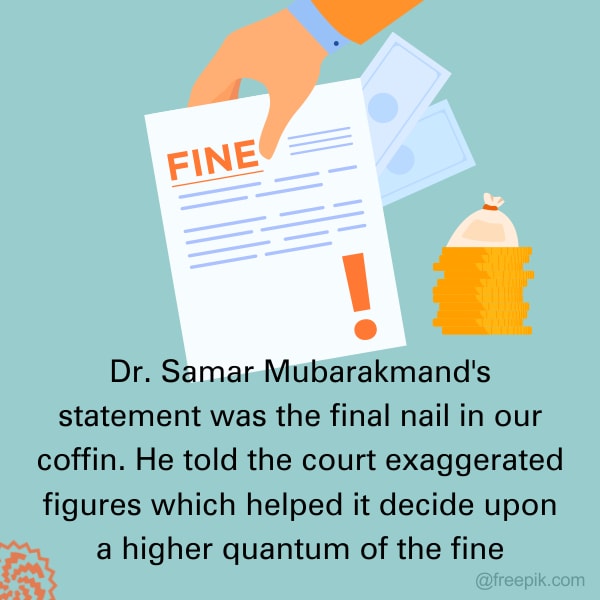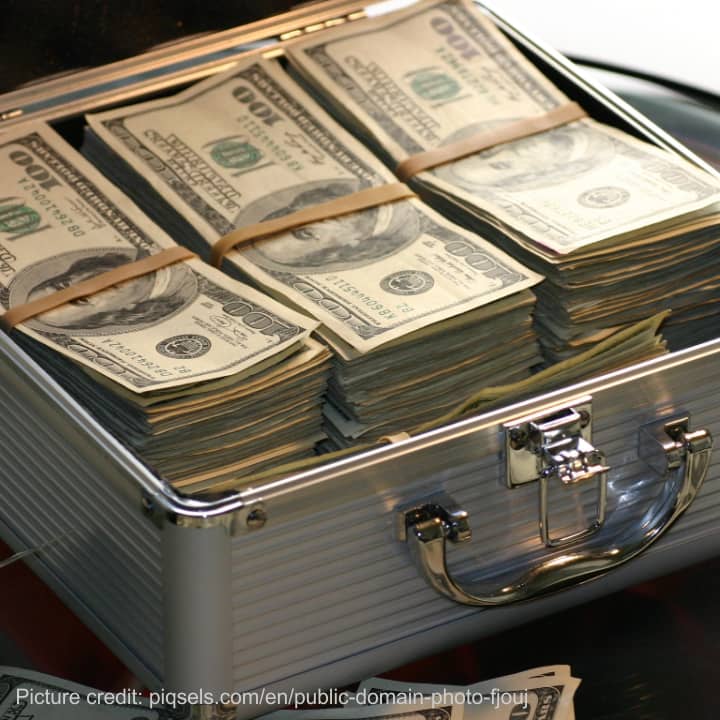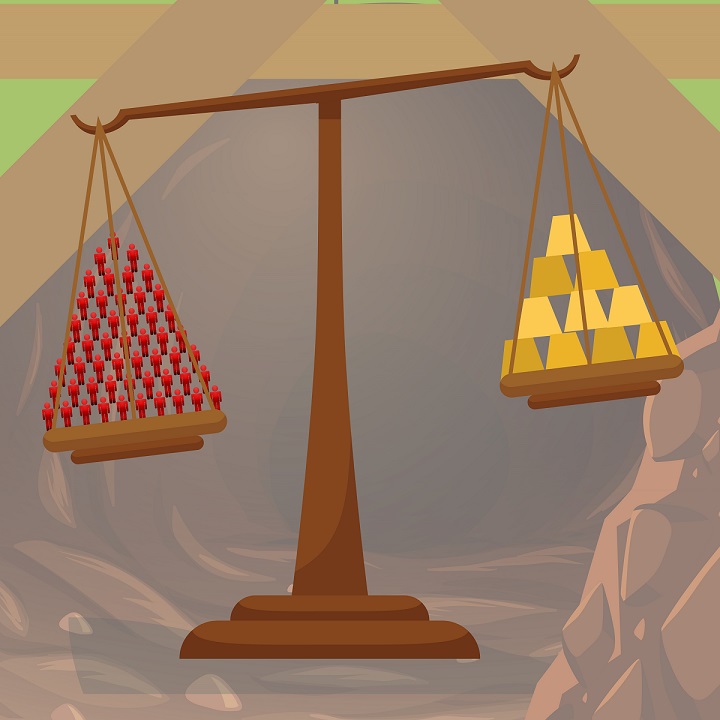Dr Samar Mubarakmand, a physicist credited to have developed Pakistan’s nuclear weapons, was called upon as a witness at the International Center for the Settlement of Investment Disputes (ICSID) in 2012. He was asked what was the estimated worth of copper and gold that could be mined from Reko Diq, a site in western Balochistan. He stated that it could generate “a profit of 2,354 million US dollars per year or a total of 131,824 billion US dollars over the life of the mine.”
A lawyer who has represented Pakistan at the ICSID hearings says Dr Mubarakmand’s estimate contributed significantly to the almost six billion US dollar fine imposed on Pakistan for violating a contract with Tethyan Copper Company (TCC) that worked on finding and extracting copper and gold from Reko Diq for years. “His statement was the final nail in our coffin. He told the court exaggerated figures which helped it decide upon a higher quantum of the fine,” the lawyer says, sitting in a cozy office in a posh Lahori neighborhood. “I don’t understand what governments and officials have been doing in Balochistan. Their sheer incompetence has cost us billions of dollars that we should actually have earned from the mining project,” he remarks.
Almost everyone directly or indirectly linked to the Reko Diq project – but not being based in Balochistan – talks like him: About massive reserves of gold and copper waiting to be taken out; about wealth of unlimited proportions that we cannot excavate only because we are so bad at everything.
To cite just one example, former finance minister Shaukat Tareen once said Reko Diq mines would be worth at least one trillion dollars. Others – lawyers, politicians and policymakers alike -- see Reko Diq as an asset whose worth could dwarf Pakistan’s current gross domestic product by a mile. They refer to it in mind boggling numbers: millions, billions, trillions. They all refer to it as ‘our’ mines, ‘our’ wealth, ‘our’ profits.
For most ordinary Pakistanis -- who may not even know where exactly Reko Diq is located – it is a promise for prosperity thwarted only by the absence of a strong commitment and a sincere will in the ruling elite. When they talk or hear about it, they become really excited while mentioning the tingle of its copper and the glitter of its gold.
Those living in and around the prospective mining area are totally missing from all the perspectives listed above. These local inhabitants might have known for generations about the existence of these precious metals right underneath their feet. This treasure trove also might have existed here for centuries -- long before their region came to be known as Balochistan and even longer before it became a part of the country called Pakistan.
When I travel from Lahore to Quetta to collect information for this report, I can see both the perspective and the landscape change as soon as I enter Balochistan. Cemented buildings, paved avenues, metalled roads, leafy streets and glittering malls of Lahore are nowhere to be seen. Equally conspicuous for their absence are fertile rolling fields, flowing canals and green-top trees. All I can see are low sandy mountains where habitation and greenery were difficult – if not impossible – to spot.
This change was accompanied by an equally striking transition in language: from mostly Punjabi to mostly Urdu with Balochi, Pashto and Seraiki thrown in for good measure.
A resident of Quetta, who happens to share the bus ride with me, asks me about the reason for my journey. “I am working on an investigate story about Reko Diq,” I reply. “Are you going to Reko Diq?” he says. I tell him that I intend only to go to Quetta but then I also ask him: “Do you think I should go there?”

“You do not have to if you only want to report the case. No one will want to read what is going on there. People will only care about a sensational headline regarding how many billions are buried there.”
Almost everyone I interview in Quetta -- from a retired bureaucrat to a small-town journalist -- shares the same sentiment though they expressed it more freely off the record than while speaking formally. As soon as the voice recorder is turned off, they stop referring to any financial and legal aspects of the case and start describing how they see the development of the mining project arrive like a death warrant for the local people. “People have lived in these areas before Pakistan came into being, or even before the arrival of the British. How can the state just snatch their land and sell it to a non-native business entity which then digs holes into the pristine sand dunes to make billions out of it ?” says a local journalist.
“We have seen the same thing happen everywhere,” says a retired provincial secretary. “Four out of Pakistan’s five gas fields are in Dera Bugti. Don’t you think it should have been Pakistan’s most developed city?”
He then mentions Saindak – another mining project in the same broader area where Reko Diq is located. The mining operations there have left enormous craters where once local people grazed their livestock and where their future generations could have gone to school. “The accounts of the company doing mining there, on the other hand, are brimful of millions. Why shouldn’t the local people be disgruntled over these projects?” he says.
What is Reko Diq?
Koh-e-Daleel (the mountain of evidence) is a sandy peak located in Chagai district in the southwestern part of Balochistan. It is more than 1400 kilometers away from Islamabad where all the policies about its fate are being made and unmade. If a resident of Koh-e-Daleel deigns to go to the federal capital to submit an application about his plight, it will take him a minimum of two days of travel by bus or rail only to reach there.
Getting to Kok-e-Daleel from Lahore is also anything but easy. First, you have to travel more than 1000 kilometers southwestward to get to Quetta. After 500 tiring kilometers on a highway going further south from Quetta, the rundown town of Nokundi appears. A further 90 kilometers to the west from the town will take you to Koh-e-Daleel.
Between the town and the mountain lies a vast stretch of a lonely desert where you will struggle to find a single human settlement because of a near fatal scarcity of food and water.
Siah Reg, meaning black sand, is a human-inhabited area located just to the east of Koh-e-Daleel. A village called Hummai is situated just under the shadow of the mountain. Most villagers here belong to Muhammadzai tribe and rear livestock to earn their living. Water is scarce here so if and when a drought strikes their livestock perishes in large numbers. Sometimes villagers have to cross into nearby Afghanistan to find as ordinary a stuff as dry firewood.
Local weather, extremely hot in summers and extremely cold in winter, could be fatal to those who are not acclimatized to it. The sand is piercingly sharp and windstorms are fierce enough to trap and blind people if they do not find a shelter immediately. The wind is pitilessly hot and strong and, therefore, is called gorich or ‘wind from hell’.
Local inhabitants have special tents made out of goat and sheep skin, called gidaan, to defend themselves against all these harsh natural elements.
Siah Reg, comprising a few villages, was -- until the 1980s -- nothing more than a derelict territory situated at the periphery of a marginalized province. And then someone came to know about the treasures lying beneath its black sand.
More than three decades ago, mining experts started stating Siah Reg, and the surrounding area, lies within the Tethyan Magmatic Arc. This copper-gold rich corridor is said to be starting from Hungary, Bulgaria, Romania and Greece. Passing through through Turkey, Iran and Pakistan, it ends in Myanmar, Malaysia, Indonesia and Papua New Guinea.
This discovery led to a change in the name of the area – from Siah Reg to Reko Diq which means sand and mounds (of gold). Over 13,000 square kilometers of local land are estimated to hold at least 12 billion tonnes of copper and 20 million ounces of gold -- the world’s fifth largest repository of these two metals.
A report that appeared in the Herald magazine in 2017 (which is also a major source for Siah Reg’s description given above) narrated that a sand storm welcomed the teams of BHP Inc – a British mining company – when they first arrived here in 1993 to inspect and drill the land. They had not anticipated the fury of the wind and were ill prepared for it. Seeing them struggle, the locals vacated their own houses for the teams to stay in them until help arrived. They themselves moved into tents.

A report that appeared in the Herald magazine in 2017 (which is also a major source for Siah Reg’s description given above) narrated that a sand storm welcomed the teams of BHP Inc – a British mining company – when they first arrived here in 1993 to inspect and drill the land. They had not anticipated the fury of the wind and were ill prepared for it. Seeing them struggle, the locals vacated their own houses for the teams to stay in them until help arrived. They themselves moved into tents.
Soon after the mining operations started, the same locals were relegated to serve the mining company as laborers and security guards – earning somewhere around 20,000 rupees a month. After mining operations closed down around two decades later, some villages had to be abandoned because the mining company’s camps were their sole source of water.
The resource curse
The gold-copper reserves at Reko Diq are neither a unique discovery of precious metals in Balochistan nor is it the first time that local communities have been kept in the dark about the fate of their own resources. There have been countless examples in the recent world history where states and international corporations have extracted valuable minerals and metals – often by employing the most inhuman forms of violence to overcome any resistance – and left their original owners by the wayside.
The standard operating procedure in such cases has been exceedingly simple: accumulation by means of dispossession. The accumulating party is either the state or a consortium of international corporations – or a combination of both -- while the dispossessed or evicted party is the local community. The dispossession is carried out both through hard and soft means: the first priority is to persuade people that their dispossession will somehow improve their lives; if that fails, bribery and corruption follow – and if that, too, does not work, coercion, violence and naked force are employed.
In India, for example, Vedanta, a mining company, became interested in Niyamgiri hills in the state of Odisha in the 1990s. It wanted to extract bauxite found in these mountains whose worth could exceed at least two billion US dollars. Dangaria Kandha, a local tribe, however, worshiped these hills as living deities so the tribespeople refused to sell their gods. Their refusal led to an India-wide movement for land rights which eventually did not let Vedanta secure any mining rights -- despite the government’s excessive efforts.
Elsewhere in the world, mining conglomerates have seldom been stopped from taking over local lands. In almost all of Africa and Latin America -- especially in places like Congo, Sierra Leone, Venezuela, Bolivia and Nigeria – the scramble for mineral resources has resulted in civil wars, rigged elections, mass migration, refugee crises, child labor and child abuse and large violent operations to get hold of indigenous lands for mining operations.
Also Read

Broadsheet case: How much money Pakistan has lost in a 20-year saga of inefficiency and mismanagement
The rapacious nature of these operations has been brilliantly captured in terms such as ‘blood diamonds’ which show how the resource-owning communities end up merely being pawns in the great – and blood-drenched -- game for power and profit.
The question arising everywhere has been the same: if a people have inhabited a land for centuries, what right does a state or a corporation have either to take over that land or to extract the resources found therein? This leads to another equally important question: why don’t communities that inhabit resource-rich places benefit from the extraction of those resources as much as the states and the corporations do?
Pakistan’s previous experience with projects aimed at resource extraction throws up some uneasy answers to these questions.
At Sui, a sub-district of Dera Bugti district in northeastern Balochistan, huge reserves of natural gas were discovered in 1952. Within three years of the discovery, the state established companies of its own -- Sui Southern Gas Company and Sui Northern Gas Pipeline Limited -- and started to supply Sui’s natural gas to almost every urban area of Pakistan – except, of course, Dera Bugti and Quetta.
Overtime, these gas fields became the backbone of the national economy, fuelling factories as far as Karachi and Faisalabad and keeping homes and offices warm in Lahore and Islamabad.
For the local residents of Sui and Dera Bugti, the prosperity they were promised after gas discovery has still not arrived. Even to this day, only 10 out of 33 districts in Balochistan have natural gas supply. In Sui town, that is home to 87 gas wells and the source of around 800 million cubic feet of gas per day, people still use wood and coal to fire their stoves.
The state has also made the entire Dera Bugti district a no-go area. Leave alone outsiders, even the locals have to show their identity documents to pass through the numerous checkpoints that dot the area. A low intensity insurgency has been going on in the district since 2006 when the chief of Bugti tribe, Nawab Akbar Bugti, who had also been Balochistan’s chief minister and governor, was killed in a military operation. It did not matter for the state that he had collaborated with it very closely for decades, helping it exploit his own people.
In Sindh, Thar, the only fertile desert in the world, has also been home to major development projects, mostly comprising coal-fired power plants. More than 52 villages and 10,000 square kilometers of land (out of Thar’s 19,000 square kilometers total land area) have been affected by multiple power plants being set up here. Local activists and experts have both pointed out that people, livestock and agriculture are all being severely affected by coal mining and power production which -- by all known accounts -- are environmentally hazardous and socially disruptive activities.
A report by the state’s own National Commission for Human Rights has conceded that much. It revealed that coal-mining is likely to result in water contamination, dust pollution, destruction of vegetation and loss of wildlife habitat in Thar. The commission has also expressed its apprehension that mining and construction of power plants might lead to the violation of laws governing land ownership and land acquisition.
A local resident highlighted these very rights while talking to a Sujag team that visited Thar a few months ago. “We have owned this land for over 300 years and have the right to keep it in our possession despite the faulty land ownership policies in the country,” he said.
People in Thar have already filed court cases, taken out protest marchers and observed hunger strikes to highlight the fact that they have never been taken into confidence over what benefits or disadvantages might accrue to them as a result of these projects. In a recent Sujag report (https://sujag.org/feature/model-villages-thar-sepa-secmc) some local residents complained that the ‘model villages’ where they have been shifted from their traditional homes, do not suit their lifestyle. “It is difficult for us, the residents of Thar, to change our lifestyle and these model colonies are not an ideal habitat to lead the life we are used to,” one of them stated.
They were also critical of the fact that their new settlements have low quality construction, are too far from roads and have groundwater unsuitable for children and livestock. The air quality around them is also worsening by the day, they reported.
A local resident, who lost his wife due to unavailability of medical help, told Sujag: “I am not ready to lose another loved one to a lung disease, which is what the development in the area is going to cost us…the air over here, too, is being contaminated.”
Which brings us back to the fundamental question: out of the billions that will be made from these mining operations and power plants, how many will go to the residents of Thar? Or to the people waiting around Koh-e-Daleel to hear some good news about Reko Diq?
This report was first published by Lok Sujag on 1 Nov 2020, on its old website.
Published on 10 Jun 2022




















